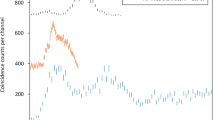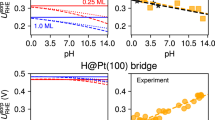Abstract
THE use of charge transfer spectra for the evaluation of ionization potentials is well known. Thus Foster has found an empirical relationship between the ionization potentials of condensed ring aromatic hydrocarbons and the frequencies of maximum absorption of their charge transfer complexes with chloranil in carbon tetrachloride1. Foster's formula is limited to the condensed ring aromatic hydrocarbons because the binding of electron donors to acceptors in charge transfer complexes is not caused entirely by charge transfer; intermolecular forces vary between different classes of molecules and influence complex formation. In general, the relationship between the ionization potential and the frequency of maximum absorption of the charge transfer complex is given by  where Ip is the ionization potential of the electron donor, EA is the electron affinity of the electron acceptor, e2/r is the coulombic interaction between the two and Δ represents all the other intermolecular forces2. There exists a type of charge transfer between molecules which does not produce a bound complex and is termed contact charge transfer3. The electron donors and acceptors are randomly disposed in solution but when they come into contact with each other momentary charge transfer takes place which gives rise to an absorption spectrum. One electron acceptor which takes part in contact charge transfer is oxygen4. Measurements made of its equilibrium constant with electron donors yield a value of zero4,5. Furthermore, the absorption band caused by this type of charge transfer increases to higher frequency without having a maximum absorption peak, the type of behaviour that can be predicted for transitions occurring between energy levels which show no minima, that is two non-bonding levels. Because there is no binding in contact “complexes” it would appear that a very general relationship can be set up between the ionization potentials of electron donors and the onset of absorption of the charge transfer band arising with oxygen.
where Ip is the ionization potential of the electron donor, EA is the electron affinity of the electron acceptor, e2/r is the coulombic interaction between the two and Δ represents all the other intermolecular forces2. There exists a type of charge transfer between molecules which does not produce a bound complex and is termed contact charge transfer3. The electron donors and acceptors are randomly disposed in solution but when they come into contact with each other momentary charge transfer takes place which gives rise to an absorption spectrum. One electron acceptor which takes part in contact charge transfer is oxygen4. Measurements made of its equilibrium constant with electron donors yield a value of zero4,5. Furthermore, the absorption band caused by this type of charge transfer increases to higher frequency without having a maximum absorption peak, the type of behaviour that can be predicted for transitions occurring between energy levels which show no minima, that is two non-bonding levels. Because there is no binding in contact “complexes” it would appear that a very general relationship can be set up between the ionization potentials of electron donors and the onset of absorption of the charge transfer band arising with oxygen.
This is a preview of subscription content, access via your institution
Access options
Subscribe to this journal
Receive 51 print issues and online access
$199.00 per year
only $3.90 per issue
Buy this article
- Purchase on Springer Link
- Instant access to full article PDF
Prices may be subject to local taxes which are calculated during checkout
Similar content being viewed by others
References
Foster, R., Nature, 183, 1253 (1959).
Briegleb, G., Elektronen-Donator-Acceptor-Komplexe (Springer-Verlag, Berlin, 1961).
Orgel, L. E., and Mulliken, R. S., J. Amer. Chem. Soc., 79, 4839 (1957).
Evans, D. F., J. Chem. Soc., 1351 (1954).
Slifkin, M. A., thesis, Univ. Manchester (1962).
Watanabe, K., Nakagama, T., and Mottl, J. R., J. Quant. Spec. Rad. Transf., 369 (1962).
Allison, A. C., Peover, M. E., and Gough, T. A., Nature, 197, 764 (1963).
Author information
Authors and Affiliations
Rights and permissions
About this article
Cite this article
SLIFKIN, M., ALLISON, A. Measurement of Ionization Potentials from Contact Charge Transfer Spectra. Nature 215, 949–950 (1967). https://doi.org/10.1038/215949a0
Received:
Issue Date:
DOI: https://doi.org/10.1038/215949a0
This article is cited by
-
On-the-fly investigation of XUV excited large molecular ions using a high harmonic generation light source
Scientific Reports (2022)
-
Effect of methyl substituents in the reactivity of methylxanthines
Journal of Molecular Modeling (2018)
-
Temperature effect on the adsorption and desorption processes in retinoic acid crystals: An electrical conductivity study
Proceedings / Indian Academy of Sciences (1988)
-
A multistage adsorption process in 15–15′cis β-carotene crystal: Electrical conductivity enhancement on chemical vapour adsorption
Proceedings / Indian Academy of Sciences (1987)
-
Evidence for the substitutional nature of the TSC traps in anthracene crystals
Il Nuovo Cimento B (1981)
Comments
By submitting a comment you agree to abide by our Terms and Community Guidelines. If you find something abusive or that does not comply with our terms or guidelines please flag it as inappropriate.



